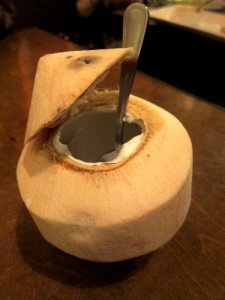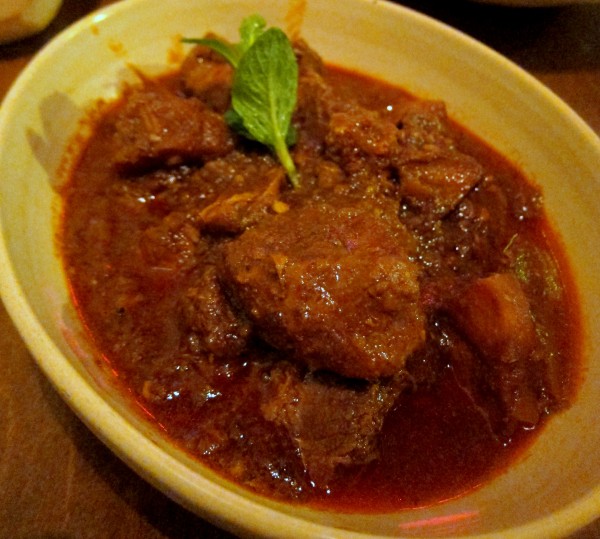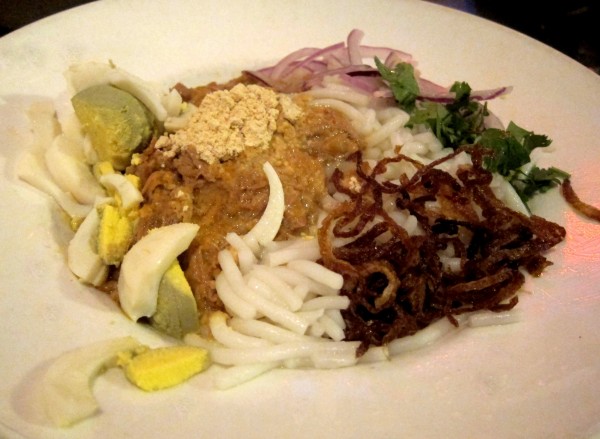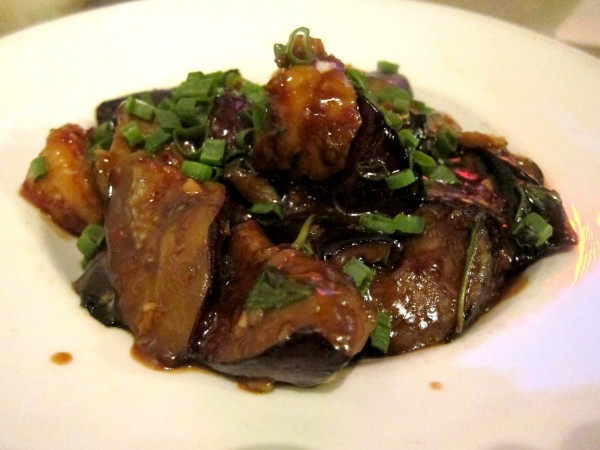
It was 1 AM Wednesday night when I saw the text message from Chris, “hey Mai, do you expect you’ll have another review ready by tomorrow?” “Yeah I think so.” “Oh good. When can you have it in? It’ll have to be sort of early if we want to get it in Friday’s paper.” Chris is the editor of Eating Berkeley, and all of my publications with them so far are online, so it’d be pretty exciting to see my name in print. The problem: it was 1 AM and I had to finish a few scripts for my research the next day. The good thing: I just had dinner at Burma Superstar (the Oakland one) earlier that evening, followed by a LOT of puer, so my eyes were opening as wide as the Pacific Ocean and ready for no sleep. I started typing away about Burma Superstar.
This morning I picked up a copy of the Daily Cal at the bus stop. It IS good to see my piece in print, although it’s on a B&W page and I don’t feel like they chose the best photo there. Later in the day I checked the online section, where it’s also published. Below is what I wrote:
A full bar and a wildly successful sister establishment in San Francisco could be the reason for the huge line outside Burma Superstar in Oakland’s Temescal District on a Wednesday night. But for me, the restaurant’s main draw is its fresh coconut, for which they charge a whopping $5. It brings back childhood flavors from the tropics, though, and that justifies everything.
It wasn’t a young coconut, and I didn’t expect it to be given that we can’t grow coconuts in most of this country. But this middle-aged coconut had such rich water and a sweet fragrant from the husk that I thought I was drinking sugar cane juice, so it was doubly nostalgic. The rest of my meal at Burma Superstar followed smoothly through every sip of that coconut water.
Burmese food is a cross between Chinese, Thai and Indian cuisines, with some dishes showing the influence of one culture more than the others. For example, the curry pork with potato has a strong Indian touch of cumin and shines with chili oil like Szechuan mapo tofu, but it isn’t sweetened by coconut milk like other Southeast Asian curries. Thus, its perfect match is the sweetened coconut rice topped with fried shallots. In fact, the coconut rice is so fluffy and flavorful that it stands well on its own and it enhances everything. In hindsight, the curry pork was the weakest link in the meal for several reasons. The description said that there was pickled mango, but we detected neither mango nor pickle. It had too little potato and too much pork, and the big chunks of pork could have used some more cooking time or fared better in smaller pieces to reduce the fibrousness of the cut.
But whatever slight disappointment we had with the curry was quickly drowned in the dense, confident garlic and chili sauce of the sauteed eggplant. The shrimp served their purpose of keeping the name of the dish not so simple as “sauteed eggplant”, but they were hardly noticeable next to the perfect eggplant — tender but not mushy, and firm but not rubbery. The nan gyi dok was a pleasant surprise. I expected thin rice noodle like in pho, served warm, but Burmese rice noodle is thick, smooth and so fragile. It was also served cold as a noodle salad with fried shallots, boiled egg, cilantro, chickpea flour and coconut chicken curry, tossed together at the table after a squeeze of fresh lemon.
As if to reward the customers for the long wait, the kitchen turns out dishes very quickly and in big enough portions that my friend and I had to ask for three to-go boxes at the end. However, that did not deter us from dessert. We hurriedly drank up the coconut water and asked the server to chop off the tops so that we could scrape off the coconut meat inside, a joy I hadn’t had for years. Meanwhile, we ordered another nostalgic comfort food — warm black rice pudding with coconut ice cream. Well, sliced almond isn’t exactly authentic Southeast Asian, but its toasty crunch earns it a home with the creamy ice cream and the gooey rice.
In the end, I wouldn’t say that Burma Superstar shines as bright as its name suggests, but the food was just as pleasant as the staff. We were full and happy when we walked out, a little slowly so not to burst. Our jackets also smelled like sauteed onion for the rest of the night, but that’s never a bad thing.

EDIT: to adhere to the Daily Cal policy, I’ve removed the quote of the commenter on Eating Berkeley. This post is not a respond to the commenter, but a reflection on my style.
When I reread my review though, I realize the depth of reviewing ethnic restaurants that I should explore. It’s not as simple as saying whether a dish is good or bad because each dish has a complex culture behind it. That makes reviewing ethnic restaurants more challenging but more enjoyable. Burma Superstar was only my second time trying Burmese cuisine, and the first time barely left any impression. Of course, my review needs a lot more research if I was reviewing Burmese cuisine as a whole, but for now, as a single restaurant review, did I do it justice?




Leave a Reply